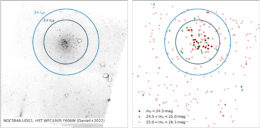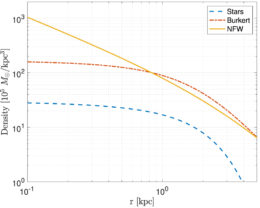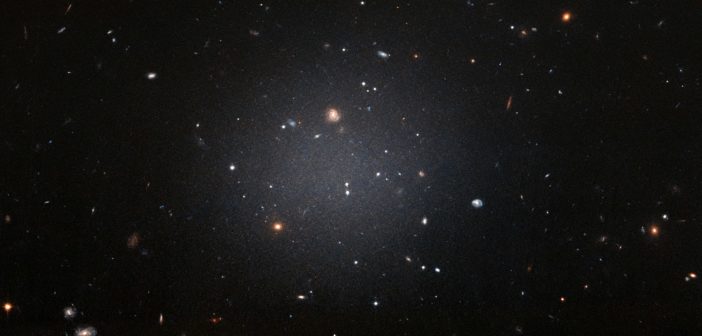Ultra-diffuse galaxies are the size of normal galaxies but far fainter, and many host an unusual abundance of globular clusters. A recent study takes a closer look at how one such galaxy’s globular clusters came to be where they are — and what this might tell us about the galaxy’s dark matter halo.
Copious Clusters

Left: Inverted Hubble Space Telescope image of UDG1. Right: Locations of objects identified in the Hubble observations, separated into magnitude bins. The brightest objects (dark red circles) are found closest to UDG1’s center. Click to enlarge. [Bar et al. 2022]
UDG1’s population of globular clusters is also remarkable because its brightest clusters are concentrated near the center of the galaxy. The arrangement is unlikely to be random — what’s responsible for UDG1’s globular cluster distribution?

Projected radial distance of UDG1’s globular clusters as a function of mass, binned three ways, compared to the predictions of simple dynamical friction theory. [Bar et al. 2022]
Influence of a Frictional Force
A team led by Nitsan Bar (Weizmann Institute of Science, Israel) hypothesized that the brightest and most massive globular clusters would naturally migrate to UDG1’s center because of gravitational dynamical friction. Dynamical friction isn’t the same as the friction that allows us to warm chilly hands by rubbing them together; instead, dynamical friction arises when objects interact gravitationally and lose a bit of their momentum in the process. In the case of UDG1, dynamical friction should cause the globular clusters to sink toward the galaxy’s center, and since the most massive clusters should experience the most friction, they should be found closest to the center.
To test this hypothesis, Bar and collaborators first used simple mathematical expressions to calculate where globular clusters with various masses would be located within UDG1 if dynamical friction is at work. Even without capturing the nuances of the system, these simple calculations matched observations fairly well, suggesting that dynamical friction plays an important role in UDG1.
A Test of Dark Matter Distributions
As a further test, the team performed detailed numerical simulations, scattering globular clusters evenly throughout a UDG1-like galaxy and allowing them to drift for 10 billion years under the influence of dynamical friction, cluster mergers, and mass loss. These simulations showed that dynamical friction could have caused globular clusters to migrate to their current positions, likely from an initial arrangement slightly more dispersed than the current arrangement.

Density profiles of three mass models tested. The Stars model is derived from the observed stellar luminosity of UDG1, while the other two models incorporate a massive, extended dark matter halo. [Adapted from Bar et al. 2022]
More work remains to be done, and the question of UDG1’s dark matter is not yet settled. The authors suggest new avenues for both theoretical and observational investigations: improved simulations of globular cluster formation can refine model results, and future data from Vera Rubin Observatory and the Nancy Grace Roman Space Telescope should illuminate the faintest globular clusters in ultra-diffuse galaxies.
Citation
“Dynamical Friction in Globular Cluster-rich Ultra-diffuse Galaxies: The Case of NGC5846-UDG1,” Nitsan Bar et al 2022 ApJL 932 L10. doi:10.3847/2041-8213/ac70df

